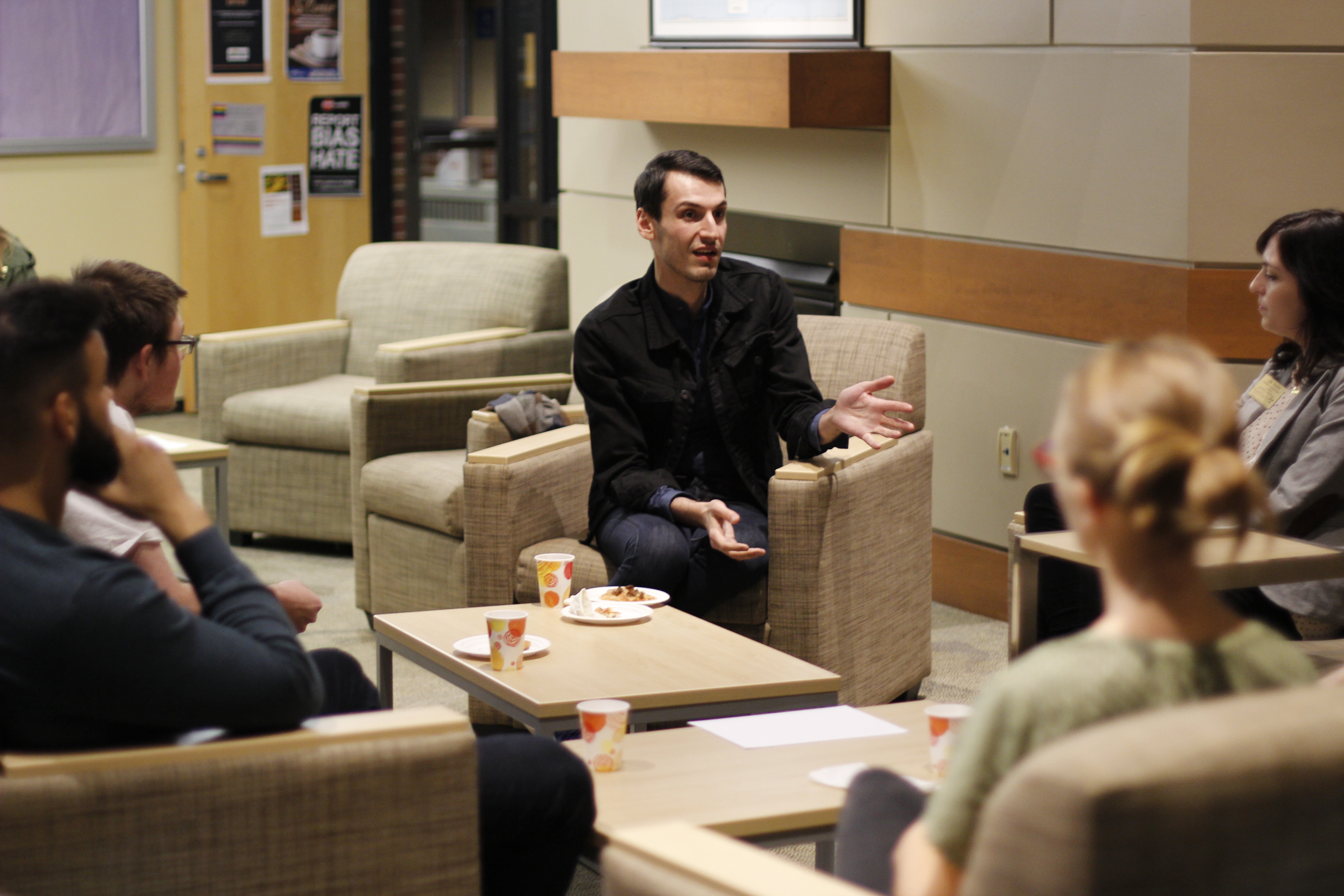This week Gustavus was proud to host author Pajtim Statovci for this year’s Out of Scandinavia artist-in-residence program.
While here, Statovci participated in discussion and lectures with students and faculty concerning his award-winning debut novel, My Cat Yugoslavia, which tells the interlocking stories of a mother and her son as Kosovan immigrants in Finland.
Statovci, originally from Kosovo, immigrated to Finland with his family when he was just two years old.
Inspired by his own personal experiences growing up, Statovci’s novel was first published in Finnish in 2014 and met with high acclaim for its unique exploration of the struggles associated with identity, homosexuality, and immigration.
It was recently translated into English, and Statovci’s second novel, currently in the translation process, will be out in 2018.
Since the Out of Scandinavia program began in 1989, Gustavus has welcomed a number of prominent Scandinavian artists and writers.
Each year, a different artist is selected for a one-week residency on campus, during which that artist gives lectures about their work, attends classes, interacts with students and staff, and attends events sponsored by the Scandinavian Studies department.
These usually include visits to the Swedish House, meet-and-greets, and public readings or discussions.
The unique work of each artist, however, means that each year’s Out of Scandinavia Week varies in content
“It originally began as kind of a program for cutting-edge authors,” said Visiting Assistant Professor in Scandinavian Studies Timothy Warburton.
“I think it’s important because it highlights kind of up-and-coming artists, so artists that wouldn’t have the resources to come to Minnesota or universities like this. Also, a lot of times novelists don’t always have the opportunity to kind of speak about their work in an academic setting — it’s always at, like, bookstores, and kind of whatever their agent chooses for them. So I know Pajtim was really excited to kind of engage with students in more academic contexts.”
The program’s ability to bring writers like Statovci to campus makes it a great opportunity for students to not only interact with different artists, but to gain a broader understanding of modern Scandinavian culture.
“Swedish heritage is very important for Gustavus, which is great, and I think in line with the mission of the department, and what I think kind of drove me to pick Pajtim is that it’s important to kind of expand the idea that people have about Scandinavia — what Scandinavia is and what Scandinavian people are — and I think it’s worked really well,” said Warburton.
Over his residency week, Statovci took part in the Russian tea, a conversation event for students, and a discussion titled “Intersectionality:
Queer Identity, Immigration, and Otherness” with Professor Robert Kendrick.
Statovci also attended classes that relate to themes in his novel, including Gender and Sexuality in Scandinavia, an FTS on Queer Theory, an anthropology course, and a history course about minorities in Europe.
At the conversation event, students had the chance to ask Stavoci questions about being a writer and listen to his ideas about finding inspiration, being an immigrant, and how he came up with the story for My Cat Yugoslavia.
When asked about the novel’s talking cat, who interacts with the protagonist throughout the story, Statovci explained the idea of animal theory, or the tendency of literature to cast animal characters as “other” characters.
Different types of animals are viewed differently in different cultures, just as nationalities are.
This ties in with the novel’s themes of immigration, identity, and voice.
“It originally began as a kind of a program for cutting-edge authors. I think it’s important because it highlights kind of up-and-coming artists, so artists that wouldn’t have the resources to come to Minnesota or universities like this.” – Timothy Warburton
Meeting and listening to Statovci discuss his work, whether in class or during the week’s events, has definitely been a thought-provoking experience for students on campus.
“I feel like he’s a really good guy — I think the first time I met him was for my class, which was yesterday,” said Junior Ayushi Kalyani, who also attended the student conversation event. “It was for history and we talked about a lot about immigration and how he feels immigration, or like being an immigrant, or being tagged in general, and it was quite fascinating. Because, you know, I’ve come across people who look at immigration differently, and identities are different for everyone. I’ve been debating like, you know, how do I identify myself — as a person the way people look at me, or as a person I look at myself?”
Sparking these kinds of questions and discussions on campus is exactly what the program hopes to do, says Multilingual and Intercultural Program Coordinator Carly Overfelt.
“One thing that we want to see… on the campus is more conversations, more interaction between students with different backgrounds — cultural backgrounds, linguistic backgrounds, whatever it may be — and one thing I think is really great about this particular choice of author is his multicultural background that he’s bringing,” Overfelt said. “… So it seems really like an exciting and important opportunity to just let students see what people do with their specific backgrounds and contexts — creating art, creating conversation, literally and figuratively.”
